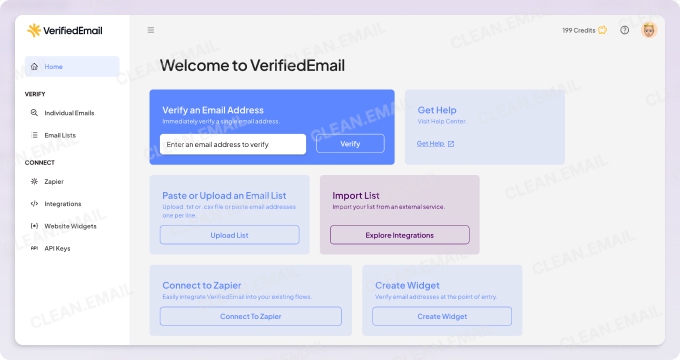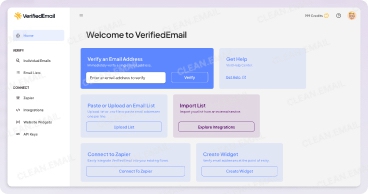What Does an Email Bouncing Back Mean?
By definition, an email bouncing back is an automated message notifying the sender that the message delivery was unsuccessful. Your recipient’s mail server has either not accepted the message, or there may be another underlying issue preventing the delivery (follow our guide on how to test email deliverability.)
Here’s what it really means:
Bouncing emails are a problem if you rely on email marketing as part of your strategy. When your emails are undelivered, your recipients cannot receive your message. The result could be lower conversions, fewer sales, less revenue, and most importantly, less time to build valuable connections with your prospects.
The Benefits of an Email Bounce Checker
One way to combat the effects of an email bounce rate is to send your list through an email bounce checker tool. Here’s why you shouldn’t skip this step:
Lower Email Marketing Costs
Sending messages isn’t “free,” per say. True, you’re not spending money on postage, but you are putting your time and effort into every email and maintaining your list. Plus, if you’re using an email platform like AWeber or Mailchimp, you’re having to pay for that technology.
You can lower your cost per message when more of your emails are delivered. A bounce rate checker tool ensures you’re only sending to valid recipients and not spending money on emails that will never result in sales.
If you are looking for a free solution for your marketing campaign, check out our top picks of the best free email list cleaners.
Improved Sender Reputation
Everyone who sends emails has a digital sender reputation. This reputation is how mail servers determine whether to send your message into the user’s inbox, their spam folder, or bounce your message altogether. The higher your reputation, the more likely you are to end up in the inbox.
Things can harm your sender reputation, however. For example, if you have a high email bounce rate, your sender reputation is likely to suffer.
Using an email checker tool can help you keep your bounce rate to a minimum and preserve your sender reputation. This ensures you can continue delivering to valid addresses without the risk of winding up in spam (check out our guide on how to check if an email address is valid.)
Better Quality Leads
No one wants to waste time, money, and effort on emailing bad leads. Those leads will never convert. Instead, verifying your email list can free up your time to focus only on valid leads.
Higher Accuracy in Email Stats
Every time you send a message, you have a number of stats that track your progress (e.g. open rates, click-throughs, conversions, etc.). Your bounce rate can skew these numbers, though. When this happens, it’s hard to assess the true results of your marketing campaign.
Cleaning your list prior to sending can give you a more realistic picture of how well your email performed. From there, you can use this data to make more informed decisions about how to improve your next email campaign.
Our Top Picks: Free Email Bounce Checkers
One or two bouncing emails here and there is nothing to be concerned about. But bouncing back emails can be a problem if left unaddressed. Using a free email bounce checker tool is a great way to ward off the effects of a dirty mailing list. Here are some of our favorites:
1. Mailfloss
If you have a large mailing list you need to verify in bulk, Mailfloss is a favorite tool among professionals. They’re an automated email bounce back checker so you don’t have to manage the process.
You can get a 7-day free trial for Mailfloss, along with two free months when you opt for an annual subscription.
2. VerifiedEmail
If you’re looking for a reliable tool to verify both large and small email lists, VerifiedEmail is a top choice among businesses. It combines real-time and bulk email verification with advanced features like free duplicate removal and customizable Website Widgets for instant validation.


New users can enjoy a FREE trial with 200 credits, and VerifiedEmail’s pay-as-you-go pricing ensures flexibility. Plus, you can save 10% on your purchase of credits by using the coupon code CLEANEMAIL10 at checkout.
3. EmailListVerify
A top-rated bounce rate checker tool, EmailListVerify looks for syntax errors, inactive and nonexistent domains, and spam traps that might prevent your message from going through. This tool is used by some of the top names in email marketing, including Mailchimp and Shopify.
You can verify 1,000 addresses for free, then opt for pay-as-you-go credits or a monthly subscription service.
4. Clearout
Clearout lives up to its name by clearing bad mail addresses with a variety of signals. It identifies emails with spam traps, emails from blacklisted domains, and emails with a history of hard bounces. Put Clearout to the test with 500 addresses for free, then you can pay as you go based on your list size.
Final Thoughts
The integrity of your mailing list is too important to leave to chance. After all the hard work you put into building a list and crafting your messages, don’t forget to spend a few extra minutes to ensure your messages will reach the right people. Even if you don’t send many emails, an email list bounce checker will quickly become a must-have tool in your marketing suite.
For more insights on what email validation is and how to validate an email address, head back to our blog.
Email Bounce Checker - FAQs
What does it mean when email bounces?
A bounce back is where your mail server tried to deliver a message, but it was unsuccessful. It “bounces back” to you in the form of an automated message letting you know the delivery did not go through.
What is a good average bounce rate?
The average bounce rate varies by industry. Ideally, you’ll aim for a bounce rate of 0%. Using a free email bounce checker is a great way to reduce the number of bouncing emails in your campaigns.
How do I reduce email bounce rate?
When your emails bounce back, it’s usually because the mail address is invalid. The best way to reduce bounce rate is to verify your mailing list prior to sending to ensure you’re only sending to valid addresses.
What is a hard bounce in email marketing?
A hard bounce refers to a message that has failed to be delivered for permanent reasons. For example, the domain might not exist or there may be a misspelling in the address.
What is a soft bounce email?
A soft bounce email happens when a message is delivered to your recipient’s mail server, but bounces back before it reaches their inbox. This may be a temporary delivery issue and can still result in a successful delivery.
How long does Gmail try to deliver email after soft bounce?
Soft bounces are typically delays in delivery. Gmail will try to deliver a soft bounce email for up to 14 hours.
How can I test if an email will bounce without sending it?
You can use a bounced email checker to simulate the delivery process. These tools analyze syntax, domain, and server response to predict if an email will bounce.
Can bounce emails affect my sender reputation?
Yes, high bounce rates signal to email providers that you might be sending to invalid addresses, which can harm your sender reputation and lead to emails landing in spam folders.
What’s the difference between checking bounce rate and email validation?
Bounce rate checking identifies problematic addresses after sending, while email validation ensures your list is clean before sending, reducing bounce risks.
How often should I check my email list for potential bounces?
It's best to perform bounce checks or validations before every major campaign and at least once every three months for ongoing list hygiene.
Can email bounce testers prevent soft bounces?
Bounce testers primarily focus on identifying invalid or inactive addresses. Soft bounces, caused by temporary issues, require monitoring and retries by your email server.
Do bounce email checkers work for all email providers?
Most tools support major providers like Gmail, Yahoo, and Outlook, but results may vary with lesser-known or private domain email addresses.
Why do email lists with verified addresses still have bounces?
Bounces can still occur due to temporary server issues, full inboxes, or email accounts becoming inactive after verification.
Is there a free way to check email bounce rates?
Yes, many services like ZeroBounce or Emailable offer free credits for bounce rate checks, helping you test your list without upfront costs.
How do I identify which emails are causing the highest bounce rates?
Bounce checkers provide detailed reports categorizing invalid emails, catch-all domains, and temporary issues, helping you isolate problematic addresses.
Can I track bounced emails automatically after sending?
Yes, many email marketing platforms and bounce checking tools integrate with your campaigns to monitor and flag bounces in real-time.



